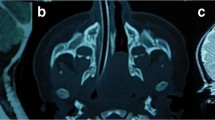Abstract
Background
Expanded endonasal approach offers a spectacular corridor for skull base tumour resection but requires reliable multilayer reconstruction techniques with a vascularized nasoseptal flap.
Method
On the basis on our substantial experience of 136 patients operated on between January 2008 and January 2020, the double pedicled nasoseptal flap technique was developed for skull base repair. The technique is finely detailed. The nasal floor mucosa was preserved. CSF leakage occurred in 4% of patients.
Conclusion
Double pedicled nasoseptal flap is a reproducible and efficient technique for skull base reconstruction after expanded endonasal approach and is associated with limited rhinological complications.


Similar content being viewed by others
Abbreviations
- CSF:
-
Cerebrospinal fluid
- DNSF:
-
Double pedicled mucosal nasoseptal flap
- NSF:
-
Nasoseptal flap
References
Boetto J, Labidi M, Watanabe K, Hanakita S, Bouazza S, Passeri T, Bernat A-L, Froelich S (2019) Combined nasoseptal and inferior turbinate flap for reconstruction of large skull base defect after expanded endonasal approach: operative technique. Oper Neurosurg Hagerstown Md 16(1):45–52
Chibbaro S, Cornelius JF, Froelich S, Tigan L, Kehrli P, Debry C, Romano A, Herman P, George B, Bresson D (2014) Endoscopic endonasal approach in the management of skull base chordomas--clinical experience on a large series, technique, outcome, and pitfalls. Neurosurg Rev 37(2):217–224; discussion 224–225
Dayal A, Rhee JS, Garcia GJM (2016) Impact of middle versus inferior total turbinectomy on nasal aerodynamics. Otolaryngol-Head Neck Surg Off J Am Acad Otolaryngol-Head Neck Surg 155(3):518–525
Hadad G, Bassagasteguy L, Carrau RL, Mataza JC, Kassam A, Snyderman CH, Mintz A (2006) A novel reconstructive technique after endoscopic expanded endonasal approaches: vascular pedicle nasoseptal flap. Laryngoscope 116(10):1882–1886
Liu JK, Schmidt RF, Choudhry OJ, Shukla PA, Eloy JA (2012) Surgical nuances for nasoseptal flap reconstruction of cranial base defects with high-flow cerebrospinal fluid leaks after endoscopic skull base surgery. Neurosurg Focus 32(6):E7
Moon JH, Kim EH, Kim SH (2019) Various modifications of a vascularized nasoseptal flap for repair of extensive skull base dural defects. J Neurosurg 132(2):371–379
Patel MR, Taylor RJ, Hackman TG, Germanwala AV, Sasaki-Adams D, Ewend MG, Zanation AM (2014) Beyond the nasoseptal flap: outcomes and pearls with secondary flaps in endoscopic endonasal skull base reconstruction. Laryngoscope 124(4):846–852
Seo MY, Nam D-H, Kong D-S, Lee JJ, Ryu G, Kim HY, Dhong H-J, Chung S-K, Lee KE, Hong SD (2019) Quality of life after extended versus transsellar endoscopic skull base surgery from 767 patients. Laryngoscope 129(6):1318–1324
Thorp BD, Sreenath SB, Ebert CS, Zanation AM (2014) Endoscopic skull base reconstruction: a review and clinical case series of 152 vascularized flaps used for surgical skull base defects in the setting of intraoperative cerebrospinal fluid leak. Neurosurg Focus 37(4):E4
Wu V, Cusimano MD, Lee JM (2018) Extent of surgery in endoscopic transsphenoidal skull base approaches and the effects on sinonasal morbidity. Am J Rhinol Allergy 32(1):52–56
Author information
Authors and Affiliations
Corresponding author
Ethics declarations
Ethical approval
All procedures performed in studies involving human participants were in accordance with the ethical standards of the institutional and/or national research committee and with the 1964 Helsinki declaration and its later amendments or comparable ethical standards.
Conflict of interest
The authors declare no competing interests.
Additional information
Publisher's Note
Springer Nature remains neutral with regard to jurisdictional claims in published maps and institutional affiliations.
Key Points
1. Optimal positioning and anesthetic protocol are crucial to avoid mucosal veinous bleeding.
2. Preserving normal sinonasal physiology is essential by excluding turbinate resection when possible. In some patients, the surgical corridor may be particularly narrow, requiring unilateral resection of a middle turbinate to optimize the workspace. When necessary, this single middle turbinectomy has no rhinological consequence. However, no inferior turbinectomy should be performed to avoid any disabling empty nose syndrome.
3. The first vertical mucosal incision must be performed behind the junction between the cartilage and the bone septum. Cartilage resection must be prohibited.
4. The root of the middle turbinate is the superior landmark of the superior horizontal mucosal incision to prevent injury of the olfactory mucosa.
5. Symmetric mucosal incisions and optimal resection of the nasal bone septum limit rhinological complications.
6. During exposure of the lateral part of the sphenoid rostrum, a gentle subperiosteal dissection is required to avoid any injury of the nasoseptal artery and subsequent delayed epistaxis
7. Care must be taken to preserve the vascularized pedicle of each NSF.
8. Adequate DNSF positioning during skull base repair prevents postoperative CSF leakage and mucocele.
9. Applying a Foley catheter for 4–5 days avoids a mobilization of the multilayer reconstruction and a postoperative CSF leakage.
This article is part of the Topical Collection on Pituitaries
Supplementary Information
Below is the link to the electronic supplementary material.
Supplementary file1 (MP4 142393 KB)
Rights and permissions
About this article
Cite this article
Baussart, B., Racy, E. & Gaillard, S. Double pedicled nasoseptal flap for skull base repair after endoscopic expanded endonasal approach. Acta Neurochir 164, 1111–1114 (2022). https://doi.org/10.1007/s00701-021-05094-6
Received:
Accepted:
Published:
Issue Date:
DOI: https://doi.org/10.1007/s00701-021-05094-6




